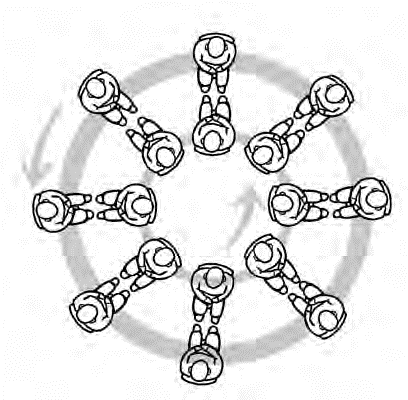First Round
Materials:
Chairs
Exercise description
The chairs are set up in two concentric circles, so that each chair in the inner circle faces a chair in the outer circle (see illustration). The number of chairs is equal to the number of participants. The participants take their seats. The people sitting facing each other are pairs.

Persons sitting in the outer circle take a card from the “hat”. The cards have statements about the rights of social groups and individuals. The same statement can be used on more than one card in the hat. Example statements:
- Women should have the right to give birth at home if they want to.
- Parents should have the right to hit their child if he/she behaves badly.
- Smokers should be allowed to smoke in a closed room if it doesn’t bother anyone.
- People should not have the right to cut down trees on their property because it is bad for the environment.
- Education should be a basic human right and should be free.
- People should be allowed to display any flag they want on their homes.
- National minorities should be privileged when it comes to employment.
- If the majority of people from a region want the region to become a separate state, this should be allowed.
- Gays and lesbians should be allowed to adopt children.
The person taking the card from the hat acts as an advocate of the statement and is supposed to convince their partner, while the other person is tasked with opposing the statement, formulating reasons why the right should be prohibited.
After 3 minutes the discussion is stopped and the people sitting in the outer circle move one place to the right. They now have a new partner and the exercise is repeated with a new card from the hat. The exercise can be repeated a few times.
Then the participants from the inner circle take new statements from the hat and advocate those statements (those rights) in order to convince their partners to support the statement. The people sitting in the outer circle are supposed to oppose the statement. (This is repeated a few more times with the inner circle moving one place to the left.)
Evaluation
Suggested questions to evaluate the exercise:
- What was it like?
- Which statements did you find difficult to defend or to oppose? Why?
- Were you listened to? Did you listen to others?
- Did people oppose you in different ways? How?
- What kind of opposition made you re-examine your position?
Notice:
